
Original Link: https://www.anandtech.com/show/1262
Kingmax Hardcore Memory: Tiny BGA Reaches For Top Speed
by Wesley Fink on March 9, 2004 11:12 AM EST- Posted in
- Memory
In the days of SDRAM 133 and 150 when Samsung chips were King-of-the-Hill, a Taiwanese manufacturer named Kingmax made quite a splash with what they called their "tiny BGA" memory modules. BGA stands for "Ball Grid Array" and it describes a memory chip much smaller than the traditional memory chips available from other memory manufacturers. It also describes an attachment technology that promises higher performance. The promise, of course, was smaller DIMMs that run cooler and faster than traditional DIMMs.
Those early Kingmax SDRAM were some of the best memory that you could buy, and Kingmax later joined a small group of memory manufacturers in being the first to bring DDR333 memory to market using the same "tiny BGA" technology. However, the transition to DDR was not as smooth as Kingmax had hoped. The company suffered from large variations in the performance of their tiny BGA memory, with some modules setting new performance records and others falling far short in the performance arena.
Kingmax has continued making performance memory with their "Super RAM" series based on the same TSOP technology used by everyone else, but they basically disappeared from the US screen for a while, at least as far as visibility to the computer enthusiast is concerned. Their DDR433 TSOP memory was competitive, but brought nothing really new to the memory market. With companies like Corsair, Kingston, Mushkin, and OCZ dominating Enthusiast Memory sales, Kingmax was competent, but had nothing to make it stand out from the crowd.
This is not to say that Kingmax disappeared. Readers in the US may not be that familiar with Kingmax, but our readers in Asia will likely know the company well. Kingmax is a very large Asian memory provider, and in Asia, they have the same kind of presence that Micron, for example, has in the US. Kingmax has continued providing memory of all types to their market, but with the new DDR500 and DDR466 memory, Kingmax is back in the Computer Enthusiast picture again. Instead of extending memory speeds to DDR466 and DDR500 with standard "me-too" TSOP memory, Kingmax has gone back to their trademark BGA memory to bring their "Hardcore Series" memory to market. With the promise of a very small size, cool operation, and breakthrough performance, we were anxious to take the new Kingmax Hardcore for a spin.
What Is Tiny BGA?
With 99% of the computer memory market using TSOP, what exactly is BGA and why does it matter? Ball Grid Array basically describes a different connection method for attaching the memory chips to the PCB or Printed Circuit Board.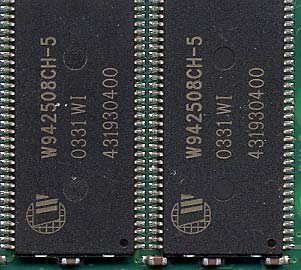
TSOP (or Thin Small Outline Package) is used in almost every other computer memory on the market. The memory is connected to the PCB by pins on the sides of the memory.

BGA does not use pins for attachment. Instead, connections are made with small balls of solder on the PCB. In the ever-increasing move to smaller signal traces in electronics, this allows a shorter connection distance and higher connector density than TSOP. The TSOP and BGA pictures above are at the exact same scale, so another advantage is the really tiny size that can be achieved with BGA memory. This design should also improve heat dissipation.
In fact, Kingmax does not even provide heatspreaders with this DDR500 and DDR466 memory. Almost every other memory manufacturer tells us that heatspreaders are needed at these high speeds, but Kingmax says they are not needed with the tiny BGA design. As memory speeds have gone up in recent months, so has the temperature. Particularly in tight SFF cases, high-speed memory can get blazingly hot. The thin small Kingmax memory is like a breath of fresh air in those configurations where heat is a problem.

Looking at a comparison with a normal TSOP module, you can see that the Kingmax PCB is also smaller than the normal TSOP PCB.

When you add the normal heatspreader to the high-performance TSOP module, the Kingmax looks absolutely tiny in comparison with the height, bulk, and weight of another DDR500 memory module.
While you may have only seen BGA on video cards in today's market, you will be seeing more of this technology with the upcoming DDR2 modules. For all of the reasons mentioned above, BGA is the package of choice for DDR2, which will be announced with Intel's upcoming chipsets for the new Socket 775 Prescott.
Kingmax DDR500 Hardcore Memory
Certainly, the flagship for Kingmax Hardcore Memory is their DDR500. While Kingmax calls their memory chips "tiny BGA", most in the industry refer to the small BGA chips as "Micro BGA". In the past, Kingmax has had a close relationship with Micron as a supplier, but we do not know who is supplying micro BGA chips for this new high-speed memory. Micron, PCS (an independent foundry), and ProMOS (Mosel) are all suppliers of micro BGA. Kingmax provided a matched pair of 512MB modules.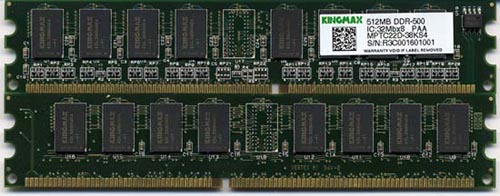
Kingmax, like other memory manufacturers, apparently purchases memory blanks and then bins the tiny BGA memory by performance.
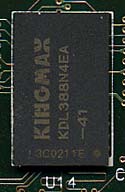
Chips are then labeled with the best chips slotted for DDR500 modules. The memory chips in 500 are rated 4.1 ns by Kingmax.
Kingmax DDR500 Specifications
| Kingmax DDR500 Memory Specifications | |
| Number of DIMMs & Banks | 2 DS |
| DIMM Size Total Memory |
512 Mb 1 GB |
| Rated Timings | 3-4-4-8 |
| Rated Voltage | 2.6V +/- 0.1V |
We confirmed the SPD timings to be set at 3-4-4-8. Kingmax claims on their website that Hardcore Memory is tested in both single-channel and Dual-Channel modes on Intel, and the memory is stated to be fully compatible with both Intel and AMD, including Athlon 64.
While Kingmax rates the DDR500 modules at 2.6V +/- 0.1V, we had no problem running the memory at 2.85V, though it rarely improved performance except at the highest overclocks. It is also worth noting that chip specifications on the Kingmax website show that the chips themselves are rated for voltages as high as 3.5V. This will not matter to most users, but it may be important to hardcore overclockers.
Kingmax DDR466 Hardcore Memory
DDR466 was also provided as a matched pair of 512MB modules.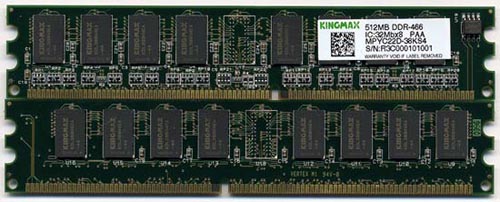
Except for the speed rating of the DIMMs, the Kingmax 466 and 500 modules are exactly the same.
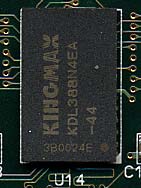
Apparently, chips for the next bin level are used for DDR466. As you can see, the memory chips are rated and labeled 4.4 ns by Kingmax. This is consistent with a DDR speed rating of 466.
Kingmax DDR466 Specifications
| Kingmax DDR466 Memory Specifications | |
| Number of DIMMs & Banks | 2 DS |
| DIMM Size Total Memory |
512 Mb 1 GB |
| Rated Timings | 3-4-4-8 |
| Rated Voltage | 2.6V +/- 0.1V |
Kingmax 466 Hardcore memory is rated at the same voltage and timings as their DDR500. We were a little surprised that Kingmax did not choose to rate DDR466 for a bit faster timings than their DDR500. However, in the past, Kingmax has been very conservative in their memory specifications. Generally, they claim that the rated timings are the worst you will see on their memory, with most DIMMs performing significantly better than specifications.
Performance Test Configuration
The Memory testbed for evaluating the Kingmax Hardcore Memory is the same used in our earlier reviews of DDR500 and other High-Speed Memory.New Memory Highs: Corsair and OCZ Introduce DDR550
OCZ PC3700 Gold Rev. 2: The Universal Soldier
OCZ 4200EL: Tops in Memory Performance
Mushkin PC4000 High Performance: DDR500 PLUS
Corsair TwinX1024-4000 PRO: Improving DDR500 Performance
Mushkin & Adata: 2 for the Fast-Timings Lane
Searching for the Memory Holy Grail - Part 2
All test conditions were as close as possible to those used in our earlier memory reviews.
| INTEL 875P Performance Test Configuration | |
| Processor(s): | Intel Pentium 4 2.4GHz (800MHz FSB) |
| RAM: | 2 x 512MB Kingmax DDR500 Hardcore Series (DS) 2 x 512MB Kingmax DDR466 Hardcore Series (DS) 2 x 512MB Corsair XMS4400v1.1 TwinX (DS) 2 x 512MB OCZ PC4400 DC Kit (DS) 2 x 512MB OCZ PC3700 Gold Rev. 2 (DS) 2 x 512MB OCZ 4200EL(DS) 2 x 512MB Mushkin PC4000 High Performance (DS) 2 x 512MB Corsair TwinX4000 PRO (DS) 2 x 512MB Mushkin Level II PC3500 (DS) 2 x 256MB Adata DDR450 (SS) 2 x 512MB Adata PC4000 (DS) 2 x 512MB Corsair PC4000 (DS) 2 x 512MB Geil PC4000 (DS) 4 x 256MB Kingston PC4000 (SS) 2 x 256MB Kingston PC4000 (SS) 2 x 512MB OCZ PC4000 (DS) 4 x 256MB OCZ PC3700 GOLD (DS) |
| Hard Drives | 2 Western Digital Raptor Serial ATA 36.7GB 10,000 rpm drives in an Intel ICH5R RAID configuration |
| PCI/AGP Speed | Fixed at 33/66 |
| Bus Master Drivers: | 875P Intel INF Update v5.00.1012, SATA RAID drivers installed, but IAA not installed |
| Video Card(s): | ATI 9800 PRO 128MB, 128MB aperture, 1024x768x32 |
| Video Drivers: | ATI Catalyst 4.1 |
| Power Supply: | Vantec Stealth 470 Watt Aluminum |
| Operating System(s): | Windows XP Professional SP1 |
| Motherboards: | Asus P4C800-E (875) with 1015 Release BIOS |
Since memory rated at DDR500 is generally targeted at the Intel 875/865 enthusiast, we only tested on our Intel test bed. Kingmax claims compatibility with AMD chipsets as well, including the Athlon 64.
Test Settings
The following settings were tested with Kingmax DDR500 and DDR466:- 800FSB/DDR400 - the highest stock speed supported on 875/865 and K8T800/nF3/SiS755 motherboards.
- 866FSB/DDR433 - a common speed achievable with low-latency DDR400 modules.
- 933FSB/DDR466 - the specified rating of the DDR466 memory modules.
- 1000FSB/DDR500 - the specified rating of the test DDR500 modules and the maximum speed that many current Intel 865/875 boards can achieve.
- Highest Stable Overclock - the highest settings that we could achieve with this memory and other memory we have tested.
Test Results: Kingmax DDR500 and Kingmax DDR466
To test overclocked stability, we used the very demanding Gun Metal 2 - - Benchmark 2, which pushes systems with its DX9 routines. To be considered stable for test purposes, Gun Metal, our Quake3 benchmark, UT2003 Demo, Super PI, Halo, and Comanche 4 had to complete without incident. Any of these, and in particular, Super PI and Gun Metal, will crash a less-than stable memory configuration.| Kingmax DDR500 Hardcore Series - 2 x 512Mb Double-Bank | |||||
| Speed | Memory Timings & Voltage | Quake3 fps | Sandra UNBuffered | Sandra Standard Buffered | Super PI 2M places (time in sec) |
| 400DDR 800FSB |
2-2-2-5 2.5V |
329.2 | INT 2892 FLT 2930 |
INT 4526 FLT 4524 |
129 |
| 433DDR 866FSB |
2-2-3-6 2.5V |
351.2 | INT 3014 FLT 3071 |
INT 4853 FLT 4847 |
120 |
| 533DDR 1066FSB |
2.5-4-4-7 2.75V |
411.9 | INT 3345 FLT 3362 |
INT 5842 FLT 5819 |
102 |
| 466DDR 933FSB |
2.5-2-3-7 2.5V |
376.1 | INT 3257 FLT 3277 |
INT 5164 FLT 5164 |
112 |
| 500DDR 1000FSB |
2.5-3-3-7 2.5V |
396.4 | INT 3341 FLT 3389 |
INT 5527 FLT 5528 |
106 |
| 528DDR 1056FSB |
3-3-4-8 2.85V |
416.3 | INT 3477 FLT 3524 |
INT 5860 FLT 5866 |
99 |
It is amazing that the Kingmax BGA modules managed to run form DDR400 to DDR500 at the default 2.5V. This is the first DDR500 memory that we have tested actually to run at default voltage over such a wide range of memory speeds. The absolute ceiling for the Kingmax DDR500 modules was DDR528, and we were able to achieve this speed at voltages from 2.65V to 2.85V. Increasing the voltage at DDR528 just allowed tighter timings. At 2.65V, we could run stable 3-4-4-8 timings; at 2.75V, 3-3-4-8; and at 2.85V, the 3-3-3-8 timings as reported in the chart. While we were able to complete our benchmark tests at 2.5V at most Memory speeds, top stability was achieved at a 2.55V or 2.65V setting on the Asus P4C800-E motherboard.
| Kingmax DDR466 Hardcore Series - 2 x 512Mb Double-Bank | |||||
| Speed | Memory Timings & Voltage | Quake3 fps | Sandra UNBuffered | Sandra Standard Buffered | Super PI 2M places (time in sec) |
| 400DDR 800FSB |
2-2-3-5 2.5V |
323.8 | INT 2783 FLT 2833 |
INT 4459 FLT 4447 |
130 |
| 433DDR 866FSB |
2.5-2-3-6 2.5V |
349.0 | INT 3002 FLT 3019 |
INT 4840 FLT 4837 |
121 |
| 466DDR 933FSB |
2.5-3-3-7 2.5V |
372.4 | INT 3179 FLT 3201 |
INT 5154 FLT 5146 |
114 |
| 500DDR 1000FSB |
3-4-4-8 2.85V |
388.8 | INT 3446 FLT 3518 |
INT 5429 FLT 5398 |
108 |
We really expected Kingmax DDR466 Hardcore Series to perform about the same as their DDR500 at lower speeds, but in fact, the DDR500 is also a better performer at the DDR400 end of the range as well. That is not to say DDR466 is not a good performer, since you would never call 2-2-3-5 at 2.5V a bad DDR400 performance. It is not as extraordinary as the DDR500 modules matching the fastest timings that we have ever seen at DDR400. DDR466 performance was very competitive with the best modules that we have tested across its operating range, with the memory topping out at DDR500. We could not achieve 1 MHz higher than DDR500, but performance was stable with higher voltage at that memory speed.
Performance Comparisons
Performance of the Kingmax Hardcore Series DDR500 and DDR466 was compared to all of the memory recently tested in:New Memory Highs: Corsair and OCZ Introduce DDR550
OCZ PC3700 Gold Rev. 2: The Universal Soldier
OCZ 4200EL: Tops in Memory Performance
Mushkin PC4000 High Performance: DDR500 PLUS
Corsair TwinX1024-4000 PRO: Improving DDR500 Performance
Mushkin & Adata: 2 for the Fast-Timings Lane
Searching for the Memory Holy Grail - Part 2
Memory performance was compared at DDR400, DDR500 and the highest stable overclock that we could achieve and would run Gun Metal 2 Benchmark 2, Quake 3, UT2003, and Super PI to 2MM places. Where the data was available, comparisons were also made at DDR433 and DDR466.
Results are compared for Quake 3, Sandra UNBufferred Memory Test, and Super PI. SiSoft Sandra 2004 reports 2 results for each memory test - an Integer value and a Float value. Results reported in our charts are the result of averaging the INT and FLOAT scores, which are normally close in value. In other words, INT and FLOAT scores were added and divided by 2 for our reported score.
DDR400 Charts
DDR433 Charts
DDR466 Charts
DDR500 Charts
Highest Memory Speed Charts
Conclusion
While BGA memory has been widely used in video cards, it just simply has not proven an effective technology for computer memory in the past. Those in the memory industry cite yields and great variations in performance as the major reasons why they have not adopted BGA for computer memory. Regardless of history, you will be seeing more "micro BGA" packaging very soon in DDR2 modules, which will be introduced with Intel's new 775 socket and new chipsets in the near future.To their credit, Kingmax has stuck with the BGA concept, and brought to market some unique high-speed memory with stellar performance curves. The advantages of BGA seem perfect for the new computers that we are now seeing. As we saw in testing, the tiny BGA modules are much smaller than TSOP memory. They dissipate heat better than the TSOP package, making them exceptionally cool - they don't even require a heatspreader for cooling at speeds like DDR500.
This makes the Kingmax DDR500 and DDR466 ideal for small dense systems like the SFF (Small Form Factor) computers that are very popular. Current TSOP memory is often cramped in the close-together memory sockets in SFF boxes, and regular memory can run very hot in those systems. Tiny BGA has a low profile, no heatspreader is required, and it runs a lot cooler in SFF boxes.
These advantages by themselves make Kingmax DDR500 and DDR466 ideal for SFF systems, but they are not nearly as important in traditional computer systems. There, we are looking for performance first. Fortunately, the performance of Kingmax Hardcore Series, in particular DDR500, is stellar. Kingmax has delivered the first DDR500 modules that we have ever tested which will run reliably at the fastest 2-2-2-5 timings at DDR400, and they achieve that outstanding performance at default 2.5V. In fact, across the performance curve from DDR400 to beyond DDR500, Kingmax DDR500 performed with complete stability at 2.5V. This also makes it the first DDR500 memory that we have tested to run at DDR500 at a default 2.5V. In fairness, we found the Kingmax most stable at 2.55V to 2.65V, but our benchmarks had no problem at all with the default 2.5V. In addition, the most stable 2.6V setting is a memory voltage option available on almost any motherboard or SFF, a far cry from the 2.75V to 2.9V often required for best performance with competing high-speed memory.
In the end, Kingmax DDR466 was very competent, but fairly average. There are many competing products that perform just as well or better than Kingmax DDR466. Choose it where cost is a factor or if you want the small profile or very cool operation. Kingmax DDR466 will not disappoint, but it does not stand out from the crowd in performance.
Kingmax Hardcore Series DDR500, on the other hand, provided spectacular performance in our tests. It proved to be exceptionally fast while running at exceptionally low voltages across the full range of memory speeds. It is one of the best at DDR500 and the best performing DDR500 that we have tested when running at DDR400. Based on the sample we tested, we could easily award our Editor's Choice to Kingmax Hardcore Series DDR500. Our only reservation is the spotty past performance of Kingmax tiny BGA modules. Once we have seen more evidence of consistent performance of Kingmax DDR500, we can be much more comfortable recommending these wonderful little DIMMs without reservation.
If you are building an SFF, you owe it to yourself to take a look at Kingmax tiny BGA memory. It is the best match we have seen to the memory requirements of most SFF systems - particularly if you intend to overclock your CPU.
If you are in the market for new DDR memory, either single or dual-channel, you should also take a close look at Kingmax along with the brands that we normally recommend. The DDR500, in particular, is all we could want in a memory module given the realities of current technology. Performance is about the same as the outstanding OCZ PC3700 Gold Rev. 2, and with Winbond chips discontinued, Kingmax DDR500 is one of the few available memories that was able to reach the fastest 2-2-2-5 timings at DDR400. The fact that it also performed to DDR528 provides the kind of headroom that you will never see on PC3200 or PC3500 DIMMs.
A word of caution is also in order. While test results with the Kingmax DDR500 were outstanding, the memory is actually rated at DDR500 3-4-4-8 at 2.6V. These are very competitive specifications at this speed, but our samples performed significantly better than this specification. We suspect that micro BGA chips which meet the Kingmax specifications for DDR500, will also perform consistently at levels like 2-2-2-5 at DDR400 - but there is no assurance that you will find the same results. The results are promising enough, however, that Kingmax DDR500 is certainly worth a close look. If Kingmax prices their new Hardcore Memory as they have in the past, you should also find Kingmax a very good value compared to competing products.







